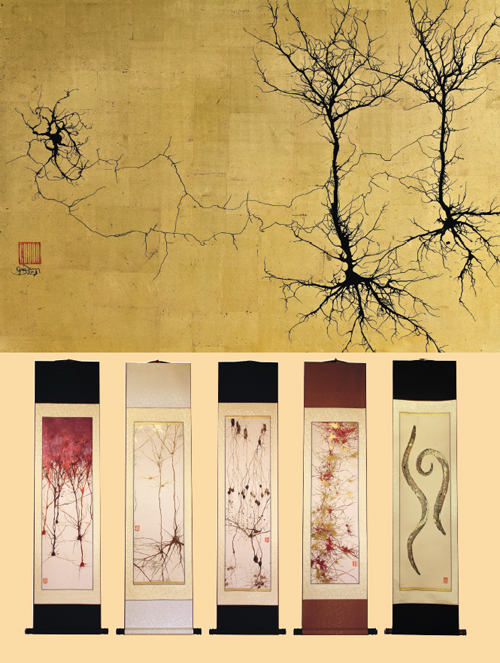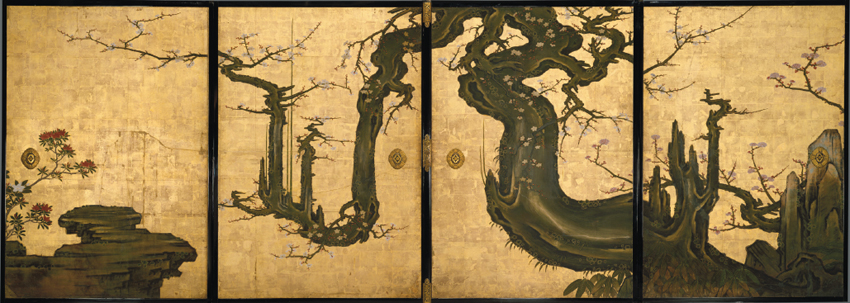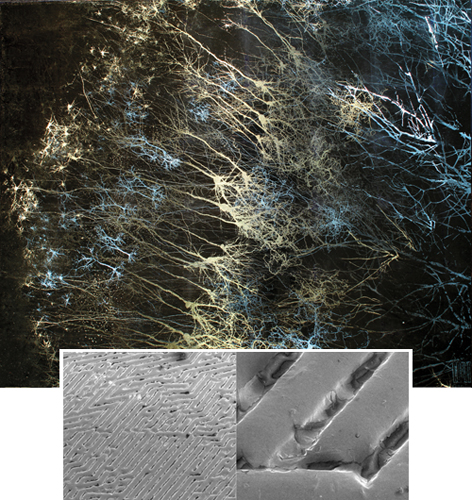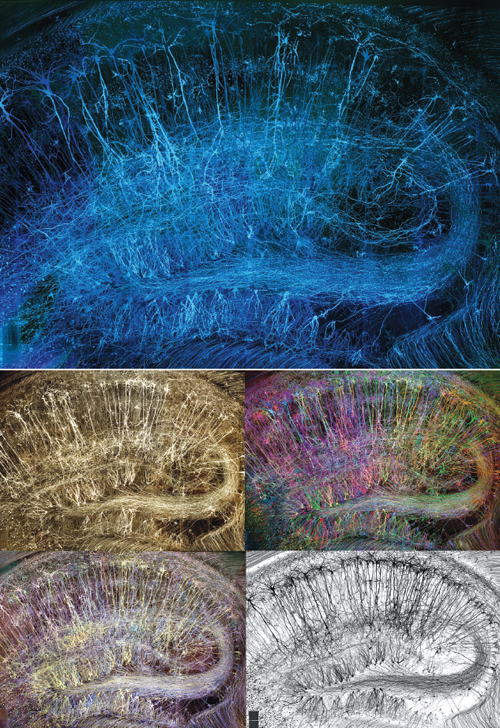Etching the Neural Landscape
By Greg Dunn
A neuroscientist-artist draws inspiration from the materials and techniques of Asian scroll painting to visualize the complex wiring of the brain.
A neuroscientist-artist draws inspiration from the materials and techniques of Asian scroll painting to visualize the complex wiring of the brain.

DOI: 10.1511/2014.110.338
Both art and science arise from our root desires to describe our experience of reality. From this starting point, the artistic and scientific paths diverge. Science describes external reality, about which we share a consensus. Art captures our internal, subjective realities. But the two sides do not always stand apart. My own work can best be described as science/art, not simply because I paint that which scientists study but because I draw evenly from artistic and scientific approaches to capture the essence of the neurons that carry sensations and produce thought.

Greg Dunn
My artistic career began during my tenure as a graduate student in neuroscience at the University of Pennsylvania. As I came to learn, molecular research can be an existential exercise in that you must rely on machines and chemical reagents to “see” your experiments. Painting provided me a welcome respite from lab frustrations because it gave me a sense of control. When painting, I can experiment and immediately see the result, judge it against my intentions, and iterate as necessary. I can convey my thoughts to the world without having to worry about grants, contaminated compounds, the politics of publishing, or an unexpected flood in the mouse room threatening to wash away my study subjects.
My graduate school days were filled with stunning microscopic imagery. Neurons, in particular, resonated with me. With their chaotic, unpredictable branching patterns, neurons have much in common aesthetically with traditional subjects of Chinese, Japanese, and Korean ink painting, such as trees and branches. Viewed as landscapes, neuronal vistas would fit easily within an Asian context. I began to experiment with merging the two.
Much of what fascinates me about the brain is the shocking juxtaposition of chaos and order that governs its function. The branching patterns of neural dendrites and axons have a degree of randomness to them that can be challenging to replicate, but this randomness makes them viscerally appealing. Eastern painters such as Kano Sanetsu and Ogata Korin have captured the spirit of randomness in their paintings of trees and landscapes through strategic use of negative space, contrast in detail, and caricaturing the unexpected. Many artists have long understood that these approaches allow the viewer to dwell on the quality of line and form, free from distractions of unnecessary detail.

© The Metropolitan Museum of Art/Art Resource, NY
I learned firsthand that the mind is much better at generating patterns than it is at generating chaos. Although my painting improved with practice and study, the breakthrough in producing the randomness I sought came from harnessing forces similar to those that govern the growth of neurons themselves. By happy accident, I found that ink blown across paper will naturally spread into the dendritic forms I desired. The reason is satisfyingly simple: A neural dendrite is essentially a thin elongating line encountering physical obstructions and chemical signals that cause it to take many random twists and turns while growing toward its target. Likewise, a droplet of ink blown across a page is an elongating line taking random twists and turns that arise from the chaotic variables of air turbulence and imperfections in the paper. Further study reveals that these branching forms exist everywhere in nature, from a lightning bolt to a thread of a galactic supercluster. This shape is a fractal. It is all around us, fundamental to our lives—in fact, this may be the very reason many of us find it so beautiful.
At first, I painted simple canvases because I wanted to master basic form and silhouette. These attributes are crucial to art for concrete, biological reasons. The visual system evolved to break up the immensely complex task of processing visual information into compartmentalized, parallel streams of distinct function to maximize efficiency of computation. Before the completed visual percept even becomes conscious, data about basic form and shape in the visual field must pass through the limbic system to obtain emotional inflection. This rapid subliminal task speeds our reactions to emotionally charged visual stimuli, resulting in visceral responses to form and silhouette.
Starting with simplicity afforded me the freedom to concentrate on honing the delicate neural processes I wanted to highlight. Taking note of the successful experiments of my forebears, I selected gold leaf as a workhorse of my art because the reflectivity of the surface beautifully enhances the contrast of fine details that would otherwise be very difficult to see.
As I learned how metal behaves under different lighting conditions, I experimented with contrasting metallic lusters. A satin metallic finish, with its relatively rough surface, will scatter photons omnidirectionally and will therefore appear to glow with light hitting the surface from any direction. By contrast, a metal surface engraved with tiny parallel ridges will reflect light strongly, but only when oriented perpendicularly to the light source. A painting of satin-finished neurons will produce a pleasingly warm reflectivity under normal lighting conditions, but if these same neurons are placed atop a horizontally engraved metal surface illuminated from above they will disappear into silhouette, because their reflected light will be of lower intensity than the background.
By taking advantage of the way the brain perceives contrast, I use reflectivity to emphasize or minimize elements. This style, which I call deep reflective gold leaf, yields complex emotional experiences for the viewer that are as much experiments in the physics of light and visual perception as they are paintings of neural landscapes. My painting Cortical Columns, which appears on the cover of the September–October 2014 issue, is an example of the deep reflective gold leaf style.
My early paintings tended to be sparsely populated canvases of neurons, maintaining a large amount of negative space to allow the delicate neural processes to breathe. Although satisfied I had made a convincing argument that the neural world fits cleanly into the lexicon of Eastern art, I was also frustrated that another of my perspectives on the brain was unrealized. In my research on neural epigenetics, I had struggled mightily with the brain’s overwhelming complexity. Now I longed to paint the brain in all its glorious depth—but how could I convey the big picture without making the art so densely opaque that it would be impossible to show each beautiful neural building block whose construction I had so painstakingly polished? How could I depict immensity and minutiae simultaneously in a flat piece of art hanging on the wall? These problems consumed me.
With the idea that the precise control of reflectivity might offer a solution, in 2013 I enlisted the help of my friend Brian Edwards, an expert in optics, photolithography, and electrical engineering at the University of Pennsylvania. Our collaboration yielded the artistic breakthrough we have named reflective microetching.
The basic principle of microetching is that photolithographic processes, similar to those used in silicon microchip fabrication, can break up images into reflective channels. These channels are defined by the angle of microscopic parallel ridges engraved into the surface of a photoresist (a photosensitive resin commonly used in the making of semiconductor chips), reflecting light in specific directions. As the photoresist itself is not reflective, the surface is coated with 22-karat gold leaf after engraving.

Greg Dunn and Brian Edwards
Once the surface is gilded, ridge angles perpendicular to photons arriving from the illumination source reflect light into the viewer’s eye, making that channel of the image appear bright. When the viewer moves to a different viewing angle, what was once a bright region becomes dim, and another channel of the image appears bright. When illuminated properly, the microetching becomes a dynamic blaze of light in which neurons appear and disappear depending on the viewer’s position. Although the effect of the microetchings is impossible to capture fully in still images, they can be viewed in the short videos online at http://www.gregadunn.com/category/microetchings/.
Adding a third reflective dimension to art provides a powerful new tool to help the viewer distinguish complicated neural forms from one another. The complete two-dimensional design of a microetching is exceedingly complex and confusing, but the reflective third dimension allows only a subset of the overall design to be visible at any given time. Furthermore, the entirety of the dendritic and axonal structure of each individual neuron becomes starkly distinguished from its neighbors, breaking up the confusing knot into beautiful and easily digestible fragments. Reflective microetchings pack many images into a single piece of art.

Greg Dunn and Brian Edwards
Because they contain no pigment whatsoever, the appearance of the microetchings depends entirely on how they are illuminated. The microetching Brainbow Hippocampus (above) is lit with multicolored lamps to illustrate the genetic technique described by Jean Livet and his colleagues in 2007, wherein each neuron in the brain is labeled with one of a hundred different combinations of fluorescent molecules, resulting in a rainbow-hued brain. Because they are free from fixed color, microetchings transform the coloration of the artwork into infinite possibility.
The successful synthesis of art and science requires careful study of the world around us, but also a careful study of the world within us. In addition, I believe it is important to develop both concept and aesthetics equally, as aesthetically compelling art invites further inquiry into its conceptual underpinning. I hope that advancements of my work captivate both scientists and nonscientists alike. Harnessing a viewer’s emotions is a key part of what makes art capable of such great impact, and if I am able to inspire people who otherwise wouldn’t have an interest in science to learn more about it, then a personal goal of my life is fulfilled.
Brian Edwards and I recently received a grant from the National Science Foundation to create an enormous microetching of a sagittal slice of the human brain (cutting through it from front to back) at as close to full complexity as possible, complete with reflectively animated action potentials and neural circuitry. We anticipate that this work will be the most detailed artistic representation of the brain ever conceived. It is slated to be on permanent exhibit at the Franklin Institute in Philadelphia by July 2016. In our laboratory, we hope to continually provide an artistic voice for the scientific community and to inspire generations of future researchers.
Click "American Scientist" to access home page
American Scientist Comments and Discussion
To discuss our articles or comment on them, please share them and tag American Scientist on social media platforms. Here are links to our profiles on Twitter, Facebook, and LinkedIn.
If we re-share your post, we will moderate comments/discussion following our comments policy.